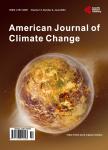Glaciers Amount and Extent Change in the Dolra River Basin in 1911-1960-2014 Years, Caucasus Mountains, Georgia, Observed with Old Topographical Maps and Landsat Satellite Imagery
Glaciers Amount and Extent Change in the Dolra River Basin in 1911-1960-2014 Years, Caucasus Mountains, Georgia, Observed with Old Topographical Maps and Landsat Satellite Imagery作者机构:Vakhushti Bagrationi Institute of Geography Ivane Javakhishvili Tbilisi State Uniersity Tbilisi Georgia Ilia State University Tbilisi Georgia Department of Geography Faculty of Exact & Natural Sciences Ivane Javakhishvili Tbilisi State University Tbilisi Georgia
出 版 物:《American Journal of Climate Change》 (美国气候变化期刊(英文))
年 卷 期:2015年第4卷第3期
页 面:217-225页
学科分类:1002[医学-临床医学] 100214[医学-肿瘤学] 10[医学]
主 题:Glaciers Dynamic Remote Sensing Glaciers of Georgia-Caucasus Mountains Kvishi Dolra and Ushba Glaciers Climate Change in Georgia
摘 要:The article presents the changes in the number and area of the Dolra River basin glaciers during the last century in connection with the climate elements. Dolra River basin is located in the south-ern slope of the Central Caucasus, in the territory of Zemo Svaneti and joins the Enguri River basin, which in its turn is the main center of the contemporary glaciation in Georgia. During the study, we used the 1:42,000 scale topographic maps of the 19th century, which were drawn up during the first topographic survey by using the plane-table surveying method. Also, we used the catalog of the glaciers of the southern slope of the Caucasus compiled on the basis of the 19th century maps in 1911 by a well-known researcher of the Caucasus K. Podozerskiy. In order to identify the area and number of the glaciers of the 60s of the 20th century, we used the work of R. Gobejishvili—the Georgian glaciologist of the 20th-21st centuries, composed on the basis of 1:50,000 scale topo-graphic maps of 1960. The data of 2014 have been obtained by the Landsat aerial images of L8 OLI/TIRS (Operational Land Imager and Thermal Infrared Sensor) taken in August 2014. In the mentioned study, except of the old topographic maps and aerial images, we used the climate in-formation that we have collected from Mestia weather stations (Mestia is the regional center of Zemo Svaneti, where the only operating weather station is located at present). Along with the dy-namics of glaciers, the course of the air temperature and atmospheric precipitation has been iden-tified in the 20th century and in the beginning of the 21st century.



